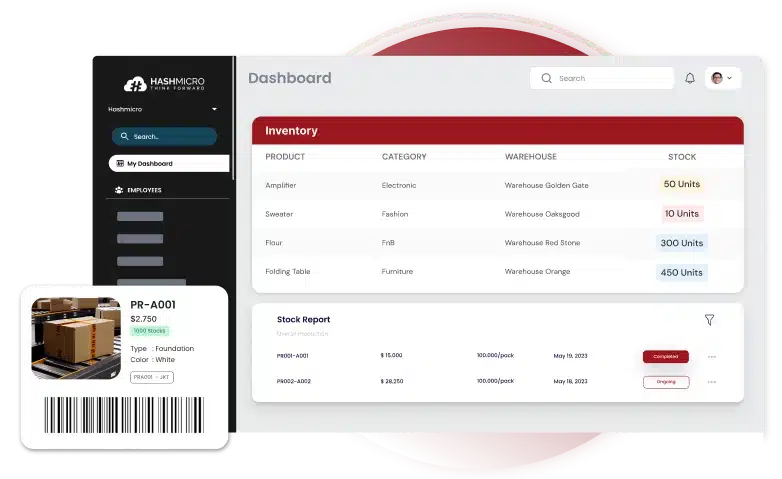Manufacturing inventory can make or break a production line. Without solid management, shortages and costly delays can quickly turn a smooth operation into a chaotic scramble. Imagine your production coming to a sudden stop; all because a critical part is missing.
Also, a 2020 survey revealed that small and medium-sized enterprises (SMEs) in the Philippines with efficient inventory management delivered 52% of their output on time, compared to 40% for those with inefficient practices. Nakaka-engganyo, di ba?
To keep production processes flowing smoothly and meet demand without a hitch, one must make sure that their manufacturing inventory is in optimal state. Read further on this article to know more about the key types and strategies that help keep production on track, no matter the challenge.
Key Takeaways
|
Table of Contents
What is Manufacturing Inventory?
Manufacturing inventory, or production inventory, involves monitoring the supplies, materials, and products used, created, and sold by a manufacturer. It encompasses all parts, finished products, raw materials, and factory supplies within a manufacturing setting.
However, an expanded definition can also include materials essential to the production process but not necessarily part of the final product reaching customers.
Accurate record-keeping of these inventory items is essential for manufacturers to maintain sufficient stock for production needs and order fulfillment. Hence, modern and advanced tools, such as manufacturing ERP software, are widely used by the factories, as it can keep track on inventory easily.
Read More: Top Construction Inventory Management Software
Types of Manufacturing Inventory
Manufacturing inventory consists of several key categories that ensure smooth production and fulfillment. Each type plays a unique role in supporting the manufacturing process efficiently. Here are several examples of manufacturing inventory types:
1. Raw Materials
Raw materials are the basic components required to create finished products. These unprocessed resources are used in various stages of production. Some products need only a few raw materials, like candles, which require wax, containers, labels, and wicks.
Examples of raw materials in manufacturing include food ingredients, plastic, metal, wood, fabric, chemicals, and minerals.
2. WIP (Work-in-Progress) Inventory
Work-in-progress inventory includes items currently undergoing production but not yet finalized for sale. Commonly referred to as assemblies, these items are partially completed. For instance, candles that have been poured into containers but not yet labeled are in the WIP stage.
3. Finished Goods
Finished goods are fully completed products ready for sale. For a candle manufacturer, this includes labeled and packaged candles ready for distribution to customers or retail outlets. Keeping accurate records of finished goods is vital to meet customer demand.
4. MRO (Maintenance, Repair, and Operations) Inventory
MRO inventory consists of tools, equipment, and materials necessary to keep the production process running smoothly. Routine maintenance and repairs require these supplies.
Essential repairs might be delayed without an MRO inventory, potentially disrupting production schedules and impacting business operations.
5. Packaging Inventory
Packaging inventory includes the materials used to pack and ship products. Some businesses classify packaging as part of MRO inventory, though this can stretch the definition.
Common packaging items include:
- Envelopes
- Courier bags
- Cardboard boxes
- Styrofoam peanuts
- Bubble wrap
- Shipping labels
- Printer ink for labels
For small businesses, visually checking and reordering packaging as needed can work well. However, larger companies often track packaging inventory more closely to avoid shortages and minimize workflow interruptions.
Manufacturing companies often use manufacturing ERP, in which every function–from production to shipping–can be carried out effectively in all-in-one manufacturing execution system.
6. Decoupling Inventory
Decoupling inventory is especially important for large manufacturers or businesses needing specific raw materials. This inventory type involves keeping extra stock of critical items to maintain production during unexpected supply disruptions.
Recent supply chain challenges have shown the value of decoupling inventory. It acts as an emergency backup and helps keep production going until new supplies arrive, though it shouldn’t be relied on as a long-term solution.
7. Consignment Inventory
Consignment inventory is owned by the manufacturer but stored at the customer’s location, typically a retailer. In this model, the retailer doesn’t purchase the inventory until it’s sold to a customer, so ownership remains with the manufacturer.
Only after the item sells and the retailer pays for it does it officially leave the manufacturer’s inventory.
8. In-Transit Inventory
In-transit inventory, or pipeline inventory, includes items that are currently being transported. Tracking in-transit inventory involves monitoring where items are, whether en route to other manufacturers, distributors, retailers, or different storage locations.
Large volumes of in-transit stock can affect cash flow, shipping costs, and handling efficiency. Careful tracking can help reduce delivery times and optimize inventory movement across the supply chain.
9. Safety Stock
Safety stock is extra inventory kept on hand to reduce the risk of running out of materials or supplies. It’s particularly useful when manufacturers receive sudden large orders or when suppliers are unable to deliver enough raw materials on time.
10. Smoothing Inventory
Smoothing inventory, also known as anticipation inventory, is similar to safety stock in helping meet demand but is planned for expected increases. While safety stock prepares a company for unexpected demand spikes, smoothing inventory is stocked for anticipated events.
For instance, manufacturers may increase their smoothing inventory before holidays when demand for food, toys, or books usually rises.
Accounting of Manufacturing Inventory
When tracking manufacturing inventory, it’s essential to consider all costs associated with its production. Manufacturing accounting provides insights into whether the investment in creating products yields a strong return. Here are three aspects an accountant tracks:
1. COGS (Cost of Goods Sold)
The cost of goods sold (COGS), or cost of sales, represents the direct costs of producing goods for sale. This calculation includes only materials and labor, excluding indirect costs like marketing or overhead.
For instance, if a product requires ₱500 worth of raw materials and 30 minutes of labor (at ₱600/hour), the COGS would be ₱800.
2. Inventory Value
Inventory value represents the total worth of stock available for sale, usually assessed at the end of an accounting period and shown on financial statements. Regularly monitoring inventory value supports revenue goal setting, profitability, and inventory planning.
3. MOH (Manufacturing Overheads)
Manufacturing overheads (MOH) include indirect costs needed to operate daily, such as utilities (electricity, water), branding, external services, and property expenses. These costs can be calculated alone or combined with COGS.
Strategies for Manufacturing Inventory Management
The way you manage manufacturing inventory depends on your business structure and operations. Here are three popular methods used today:
- Pull Strategy:
In the pull strategy, products are supplied based on actual customer demand. This keeps inventory costs low, but it can be challenging to ensure that enough stock is available to meet customer delivery expectations. - Push Strategy:
With the push strategy and implementing manufacturing asset management software, production is based on forecasts of customer demand. This approach reduces the risk of running out of stock, but if demand is lower than expected, excess inventory may result, which can add to costs. - Just-in-Time (JIT) Strategy:
JIT combines elements of both push and pull strategies. This strategy uses demand forecasting and keeping raw materials ready, but production only starts when there’s an actual need for the product. This strategy helps reduce inventory costs while still meeting demand accurately.
Manufacturing Inventory with HashMicro Manufacturing Software
Effectively managing manufacturing inventory can be challenging without the proper tools and software. Fortunately, many specialized solutions are available for manufacturers. Meet the inventory management system solution designed to take control of your manufacturing inventory.
HashMicro Manufacturing Software doesn’t just track inventory. Moreover, it also helps you keep costs low, reduce waste, and ensure every item you need is where it should be, exactly when you need it.
You can also try the no-credit card, no-cost demo to consult with the expert team about your needs and how the software can fulfill them. In addition, HashMicro Manufacturing Software has a variety of useful features to help manufacturers manage their production from end to end.
Here are HashMicro’s features that boost manufacturing inventory management:
- Raw Materials, WIP, and Finished Goods Management: Tracks all inventory at each production stage, so you know exactly what’s available, in progress, or ready for sale.
- Integrated Real-Time Stock Management: Helps you prevent running out or having too much of any item by maintaining precise and real-time stock levels.
- Materials Requisition/Purchase Planning (MRP): makes sure you always have the appropriate quantity of stock by automatically planning and ordering materials depending on production demands.
- Production Cost Tracking for Materials, Overhead, Labor, and Subcontracting: gives you a comprehensive picture of all manufacturing costs, thereby helping in cost management and tracking your subcontract spending.
- Comprehensive Quality Checks for Production Goods: Checks the quality of materials, in-progress items, and finished products to reduce waste and keep customers satisfied.
- Master Production Schedule Based on Forecasted Demand: Production is planned according to anticipated demand, which helps you fulfill client demands without going beyond.
Conclusion
A variety of stock types required for efficient production and order fulfillment are included in the manufacturing inventory software. Manufacturers can precisely satisfy production demands by monitoring raw materials, work-in-progress, finished items, and MRO inventories.
HashMicro Manufacturing Software takes a game-changing approach to inventory control, combining real-time tracking, automated planning, and quality checks in one powerful system. Say goodbye to stockouts, overstocking, and the stress of manual tracking. Ang aming software ang bahala.
Why wait? Try our free demo and see firsthand how HashMicro can help you cut costs, reduce waste, and easily stay ahead of demand!

FAQ About Manufacturing Inventory
-
What are the main challenges in manufacturing inventory management?
Manufacturing inventory management faces challenges such as demand forecasting inaccuracies, supply chain disruptions, maintaining optimal stock levels, and managing lead times. Implementing robust inventory control systems and adopting strategies like Just-In-Time (JIT) can help mitigate these issues.
-
How does technology impact manufacturing inventory management?
Technology enhances manufacturing inventory management through automation, real-time tracking, and data analytics. Utilizing Enterprise Resource Planning (ERP) systems and inventory management software improves accuracy, reduces manual errors, and provides insights for better decision-making.
-
What is the role of inventory turnover ratio in manufacturing?
The inventory turnover ratio measures how often inventory is sold and replaced over a period. A higher ratio indicates efficient inventory management and strong sales, while a lower ratio may suggest overstocking or weak sales. Monitoring this ratio helps manufacturers optimize stock levels and improve cash flow.























